Slide Viewer: Tests and Purchase Tips
Your slide projector stands dusty in the cupboard and does not work anymore and you have no light panel? But you want to view or scan a few slides of your collection or the whole archive? You think scared on a stiff neck by having to hold each of the slides in front of the window in order to view the picture? You want to quickly show one or a few slides to other people?
The a slide viewer that forms a bridge between the light panel and the slide projector, exactly the right thing for you. Additionally, you do not have to assemble anything like in case of a projector and a screen, as it is immediately taken out and ready for use.
The are slide viewers starting from the most simple models that are simply hold against the light up to quite practically equipped devices that provide a background illumination with batteries and/or mains operation and almost offer the same viewing comfort as a projector with a slide slot and a selector switch. Almost all of them not only have in common the possibility to quickly view or sort some slides, but also specially the integrated viewing lense that offers the usual magnification factor of 2x up tp 3x. Thus, those who do not constantly but sporadically work with slides or want to view them have herewith an alternative to the light panel and magnifier or to the projector with screen.
Different Structures of Slide Viewers
As already mentioned, different forms of slide viewers offer more or less luxury. The very simple models are some plastic devices that only weight a few grams and that have a diffusing glass or milk glas at the back side and an adapter at the front to put each of the slides in. The slides have to be hold against the room or window light in order to see the picture. Thereby, the most simple devices do not even have a magnifier, are not much bigger than the slide itself and only offer the diffusing surface for a more uniform lighting. Some bit better devices already enlarge the slide by the factor 2. The exception are those viewers that are actually mini light panels, thus have a battery-powered background illumination but do not offer a magnification.
The manual devices (still) offer a little more comfort and do not have to be hold against the light as they have an integrated background lighting and offer some magnification factors of 2x up to 3x by a front magnifier. In such devices, the slide is also inserted from above or from the side.
But the table devices are more practical and comfortable offering an angular insight for the viewing ergonomics. Such models have throughout an enlighted diffusing screen at the background that is battery- or electricity operated and also a magnifying front lense. For the devices with (also optional) battery operation, we principally recommend accumulators but there is to mention that the common accumulators sold in the market feature a lower voltage than the batteries (1,2 instead of 1,5 Volt), and this is the reason why the background lighting is a little weaker.
The facilities oscilate in the magnifying factor, the brightness of the integrated lamp as also in the handling by different possibilities of the insertion of the slide. The most simple variant offers a slide feeder adapter of which the slide has also be removed, others offer a possibility of slipping a film strip and a collecting pan for those slides that are already viewed. This enables a faster viewing sequence of several slides.
The most comfortable devices offered in the market look very similar to a slide projector. Apart from the fact that they are are little smaller, they only differ from a slide projector by the fact that the image is not projected and that the slide switch control has to be manually handled. The slide adapter is divided by the slide switch control that first transports the slides located in the filling adapter one by one first to the viewing position and the to the collecting pan. Depending on the thickness of the slide, up to 40 slides that can be viewed sequentially fit into such a device. These devices are principally operated by the network. Beside an obligatorily affixed rotatable and statable base in order to adjust the viewing angle, there are only some differences in the design, handling comfort and amplifying comfort recognizable.
In the following, we will present some slide viewers to you from different categories and will talk about their handling as also their advantages and disadvantages.
Reflecta Slide Viewer B36
The slide viewer with the approximate size of a mobile phone, is a special exception in our test field. It is the only device that does not have any viewing lense and it offers no possibility of an amplification respectively. In the end, this dressy small device works like a small light panel.
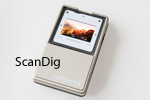

The slide to be viewed is simply layed on the light panel by pushing it between the light panel and the springy transparent cover. This secures the slide against dropping out in all positions. Thus, it is not necessary to keep the light panel in an horizontal position but also - as in the case of an image on the display of the mobile phone that one wants to show to some friends - in vertical position or even upside down.
The back part can take two batteries or accumulators of the size micro (AAA) and the small switch at the right side provides light if needed. Positioned on the desk, it does not need much space and it is just the right thing for viewing some few slides for which no amplification is needed. The slide viewer B36 is a dressy small device to go in the classic shape of a mobile phone, is of a good and practical appearance and lies well in the hand.
Kaiser Slide Viewer Diascop modulo
The name is the motto. although the Kaiser Diascop modulo is practically also a mini light panel, the device is, thanks to the comprehensive equipment, applicable in many ways. As it is the case of the small pocket viewer B36 of Reflecta, it is applicable as a non-amplifying light panel with the difference that,instead of a transparent slide holder, the slide has a fixed adapter with an inset that avoids the falling out of the slides as safely.
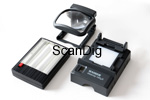
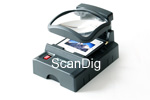
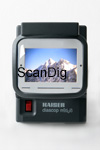
Now, one clou follows the other one by one. In order to get an amplifiying factor of not less than 2,5x, a folding magnifier can be fitted. With an extra rack, this folding magnifier is also applicable as a table magnifier for non-transparent originals or any other objects. The light panel structure is adapted in its size and function to an excellent hand lamp of Osram, the "Dulux Mini", that, once clicked into the casing, provides some light to the light surface. Dismantled, this lamp is an independent handy panel light that can be used as a torch, an emergency light or, for example, as a light for the tent, the car or the cellar. This light source is operated by some standard mignon- (AA) batteries or accumulators.
In summary, a multifunctional device that, beside the possibility of slide viewing and amplifying, is also apt for the daily use. With the Kaiser Diascop modulo, one practically gets 3 devices in one: a slide viewer, a panel light and a magnifier. All together, very useful things for the daily life.
Kaiser Slide Viewer Diascop mini2 and Diascop mini3
These devices of the same structure of the house Kaiser Fototechnik only differ in their amplyfying factor. As the denomination already indicates, the Diascop mini2 is of an amplifying factor of 2x, and the Diascop mini3 of 3x. Both devices are very handy and can either be hold with the hand as also used on the table due to the foldable base.
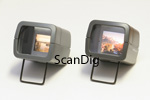
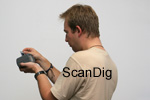
Both slide viewers have a slide insertion at the upper side in which the slide can be manually inserted and must also be hold there. As the devices do not have an on/off, as soon as the user inserted the slide into the device, the light comes on automatically, as then the slide is pushed on the contact that makes the light on. This is very practical insofar, that the background light goes off in case of non-use. Kudos to the tinkerers of the house Kaiser for this construction!
The resilience of the electric contact additionally provides that the slide can be tangibly removed from the slide adapter. By tearing the upper casing at the back, one gets to the battery case. Two standard mignon- (AA) batteries or accumulators do their job there. Thus, all around, some practical viewers that can be either used on the table as also, due to their compactness, be passed over to those who are interested.
Kaiser Slide Viewer Diascop 1, Diascop 3 and Diascop 4
The slide viewers Diascop 1, Diascop 3 and Diascop 4 from Kaiser are of the same product family, look quite similar and principally work in the same way. But they differ in the amplifying factor of the front lense, in the way of the electrical operating method as also referring the comfort in relation to a missing or existing collecting receiver in the case of the dropshaft models. All three can surely be described as table models, but they are so compact and light that they - with a small restriction of the power cable models just because of the cable - can be handed round. Beside the possibility offered by all three models to view some framed slides, they also have in common the possibility to view complete film strips or even film reels due to the two sideways guiding slots. Therewith, these slide viewers are the only models that could be also described as film strip viewers.
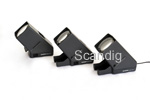
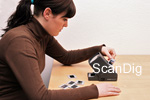
The Diascop 1 is the most simple model of this device category, it offers a 2x amplifying front lense and battery or accumulator operation that is enabled by two C cells. These are tapped over a sidely located flip switch or left alone. The slide feeding takes place at the backside of the device by a single shaft. If one wants to remove the slide, one simply presses on the spring lever at the front part so that one can pull it out again.
Either the Diascop 3 as also the Diascop 4 offer, beside a 3x amplifying front lense, two more features. On one hand, a slide dropshaft with a connected collecting tray, and in case of the Diascop 3 on the other hand, the possibility of the optional operation of the device, either by batteries or power supply. But for the power supply, the optional power supply unitfor the Diascop 3 has to be purchased additionally. In the case of both models, the dropshaft provides the advantage not to have to remove the slide manually by pulling it upwards but to let it drop out at the push of the button of the sidely located sprung lever.
There is then the collecting tray that can, depending on the slide thickness, take up to ten slides. The whole issue offers the advantage of a faster viewing sequence, if wanted. A sidely located light switch at the Diascop 3 determines the power supply from the battery case (2 x C cells) or, as said, optionally from the plug. The Diascop 4 does not need this due to the reason it is purely power supply operated. As soon as the cable is connected, its background illumination is working.
Slide Viewer Kaiser Diascop 50N and Reflecta B220
The upper class of the slide viewers are represented by the Kaiser-slide viewer Diascop 50N and the Reflecta slide viewer B220. The devices of a similar structure basically only differ in the design and the amplifying factor. While the model of reflecta offers an amplification of 2,5x, the Kaiser dfevice counters with an amplifying factor of 3.
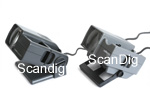
Both offer a filling shaft for up to 40 slides (depending on the frame thickness) and a slide charge bar that enables a comfortable switching of each of the slides. Principally, the bar always changes one by another, except in case of the first and the last one. The procedure of the kaiser device is more comfortable, that exchanges one slide for another without any dark interruption, whereas the Reflecta viewer features a bright interruption. The slider of the kaiser viewer runs more smoothly and easily and appears to be of a higher quality and more sophisticated.
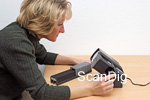
In general, the kaiser device seems to be higher-valued and better processed. Contrary to the a little fiddly knurled screw in the case of the Reflecta-device for the adjustment of the angle of the adjustable foot, it has a handy twist grip. Also the power supply guideline is in the case of the kaiser device more thought-out being designed straight backwards so that it does not disturb during the adjustment of the foot. Another plus for the Diascop 50N of Kaiser is the (in case of Reflecta missing) option to have the possibility to push film strips through a vertical shaft.
Due to the relatively high shaft capacity of both devices, both are apt for those who want to view some dozens or even hundred slides in a fast and easy way. They only have to be reloaded from the magazine and/or sorted from the "shoe box".
Slide Viewer Reflecta B250
Among the slide viewers, the Reflecta B250 is an absolute highlight. But this slide viewer is so similar to a light panel in its structure, function and handling, that we describe it in detail on our Page of Light panels and also show some numerous application images.
Summary, Conclusion
The tested slide viewers cover all requiremens from "rapidly view" up to "contemplation of the archive", each of the devices has its place and meaning in the market. Thus, what is decisive for the purchase is not only the price but also the purpose of use and the respective comfort requirement of the user.
The analog "fotohandy" Reflecta B36 is a nice gag and sufficient for the occasional viewing of a slide, the Diascop modulo from Kaiser Fototechnik is a smart universal piece of a high efficiency and daily usage. Real and pure slide viewers with amplification factors from 2x up to 3x are the Kaiser devices Diascop mini2, mini3, 1, 2 and 4, by which there is to differ between the amplifiying factor and more or less comfort (e.g. dropshaft, baterry or power supply operation), as also reflecta B220 and the top-device Kaiser Diascop 50N, both specially offer the comnfort of the slide switcher with a slider and can therewith permit a bigger amount of slides and a more comfortable viewing sequence. Therewith, each slide viewer offers a sense in an individual way and fill the gap between a slide projector and plus screen and light panel plus amplifier.
Back to the index hardware tests
|